Weather has always been of the first importance at sea. In the age of sail, the reasons for this were obvious, but while officers no longer have to worry about the weather gage,1 they still must consider what wind and wave will do to their ships, and to aircraft they may be attempting to operate. And ships today must fight in conditions that would have had Nelson's captains looking to the survival of their vessels.
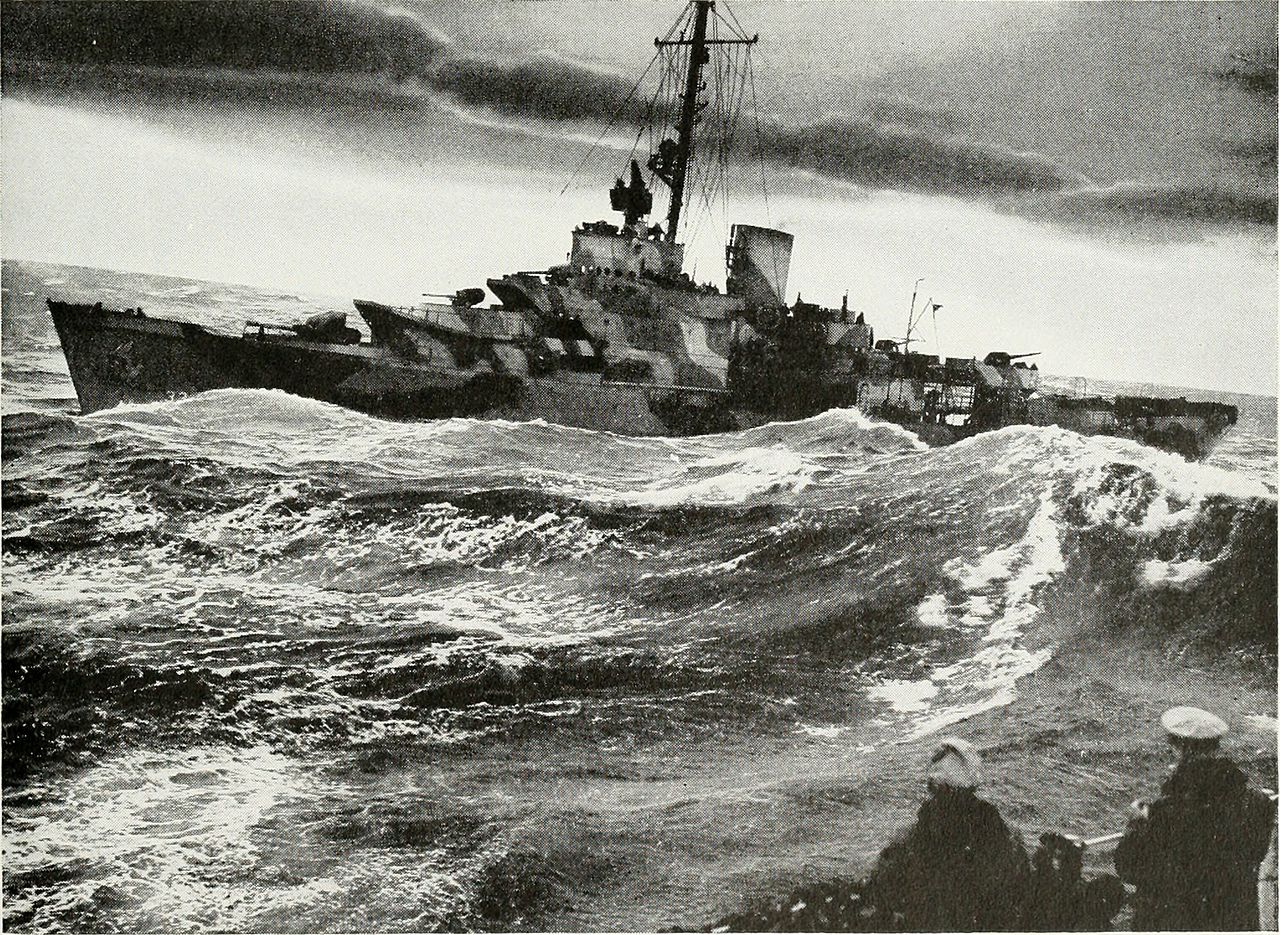
A Coast Guard Cutter battles heavy weather in the North Atlantic during WWII
The biggest effect of weather is on the motion of the ship. Besides the obvious motion of rolling, pitch and heave2 are also important to the efficiency of the crew, although in different ways. Any physical activity, such as loading a gun, is made substantially more difficult in cases of high lateral acceleration. This is only loosely related to the actual angle of roll, as a ship with a large metacentric height might roll to angles nearly as great as a less stable ship, but the lateral accelerations will be substantially higher as it snaps back upright. High roll rates also produce serious problems for fire control, although this is difficult to decouple from the effects of acceleration. Even mechanical systems like modern power-worked guns lose efficiency rapidly in these conditions.
The following video, showing clips of escorts in the North Atlantic, will give some idea of just how bad weather at sea can get.3
However, what lateral acceleration does not do is produce seasickness, which has obvious effects on the efficacy of the crew. That is a product of vertical acceleration, which is produced by a combination of heave and pitch,4 and also impairs decision-making among those who aren't physically ill.5 Pitch is obviously irrelevant amidships and worst at the bow and stern, so designers place critical spaces like the bridge and CIC to minimize motion. The best way to minimize both motions is to make the ship longer, with a length of about 250' being considered necessary today in the North Atlantic, the worst piece of ocean that is regularly considered by naval planners.6 Even bigger ships are badly affected. The 360' Leander class was expected to lose 10% of its capability in Sea State 5 (waves 8-12.5', 21% of the time in the North Atlantic), 30% in Sea State 6 (12.5-20', 13%) and 95% in Sea State 7 and over (20+', 7%). Conditions in smaller vessels of the WWII era would have been considerably worse.
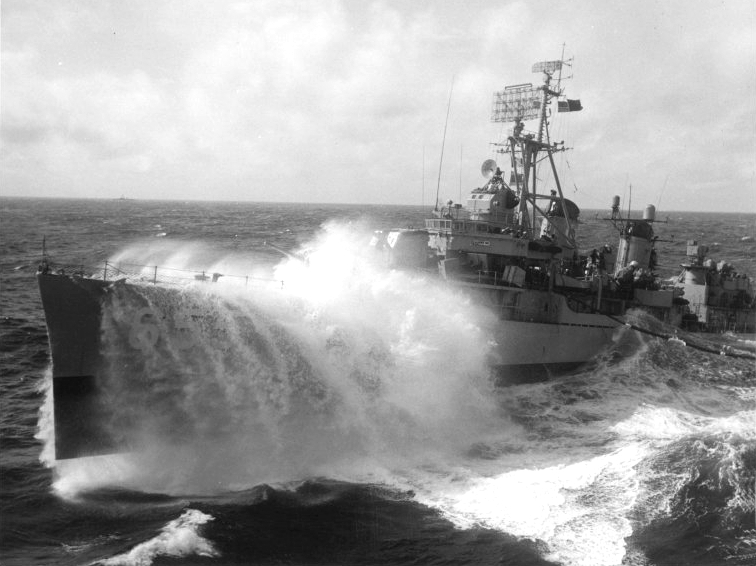
Destroyer John Hood, about to suffer from slamming
Rough seas affect the ship as well as the men aboard her. They increase the power required to drive a ship at a given speed, and often make the propellers less efficient as well, further limiting the speed a ship can make. Other effects, ultimately the results of pitching, can force the captain to reduce speed further. If the bow comes clear of the water, as can happen when a ship is driven fast in rough seas, it comes back down hard. This effect, known as slamming, is very good at breaking sonar domes, and can damage the hull, too. Slamming is most likely in long, shallow ships like WWII-era destroyers, while bigger ships with greater draft do not suffer as badly. A fast-moving ship can also take water over the bow. Spray makes it unpleasant to be on deck, while full-fledged green seas can wash away men and break equipment. Wetness is usually caused by insufficient freeboard,7 although some ships, like the Iowas, were wet because of lack of buoyancy in the bow. In really extreme cases, the ship can pitch enough to bring the propellers out of the water. This sends them racing to high speed as they are unloaded, and obviously stops them providing any meaningful thrust.
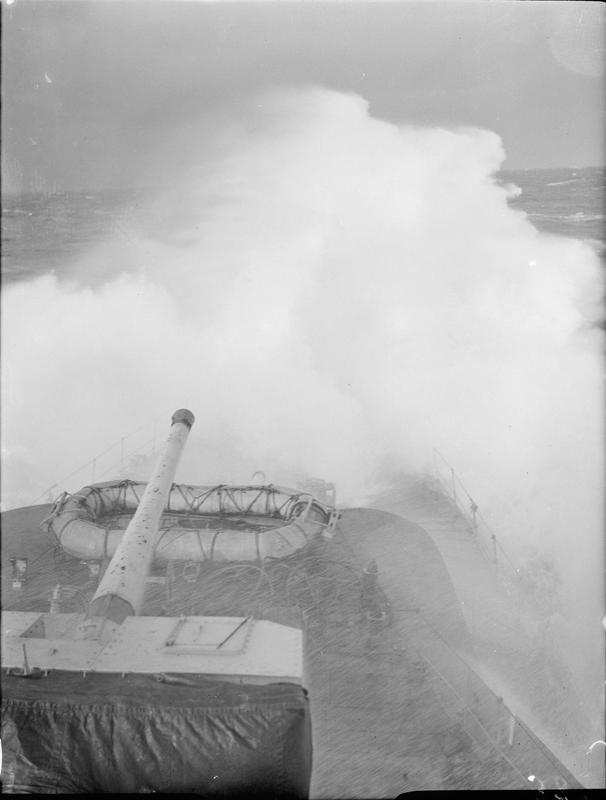
HMS Inglefield takes water over the bows in the North Atlantic during WWII
Wind and waves can hinder sensors as well. Rain, cloud, and fog obviously make it impossible for lookouts to see enemies, but even when visibility isn't totally blocked, weather can hinder lookout performance. U-boats often attacked with wind and seas astern, forcing lookouts to stare into the spray. Nor are the effects limited to visual detection. Rough seas produce spurious radar returns, which cluttered the simple radar screens of WWII. Today, digital signal processing has mitigated this problem, but it still makes finding small targets difficult. Atmospheric conditions can also cause anomalous propagation, where radar beams travel in unexpected ways, hiding some targets and revealing others at great range. Similar effects are seen with sonar, although the details are outside the scope of this post. Storms produce increased background noise, which hinders passive sonar performance. Active sonar is also affected, both by the background noise and by problems like slamming and bubbles being drawn under the ship into the vicinity of the sonar dome.
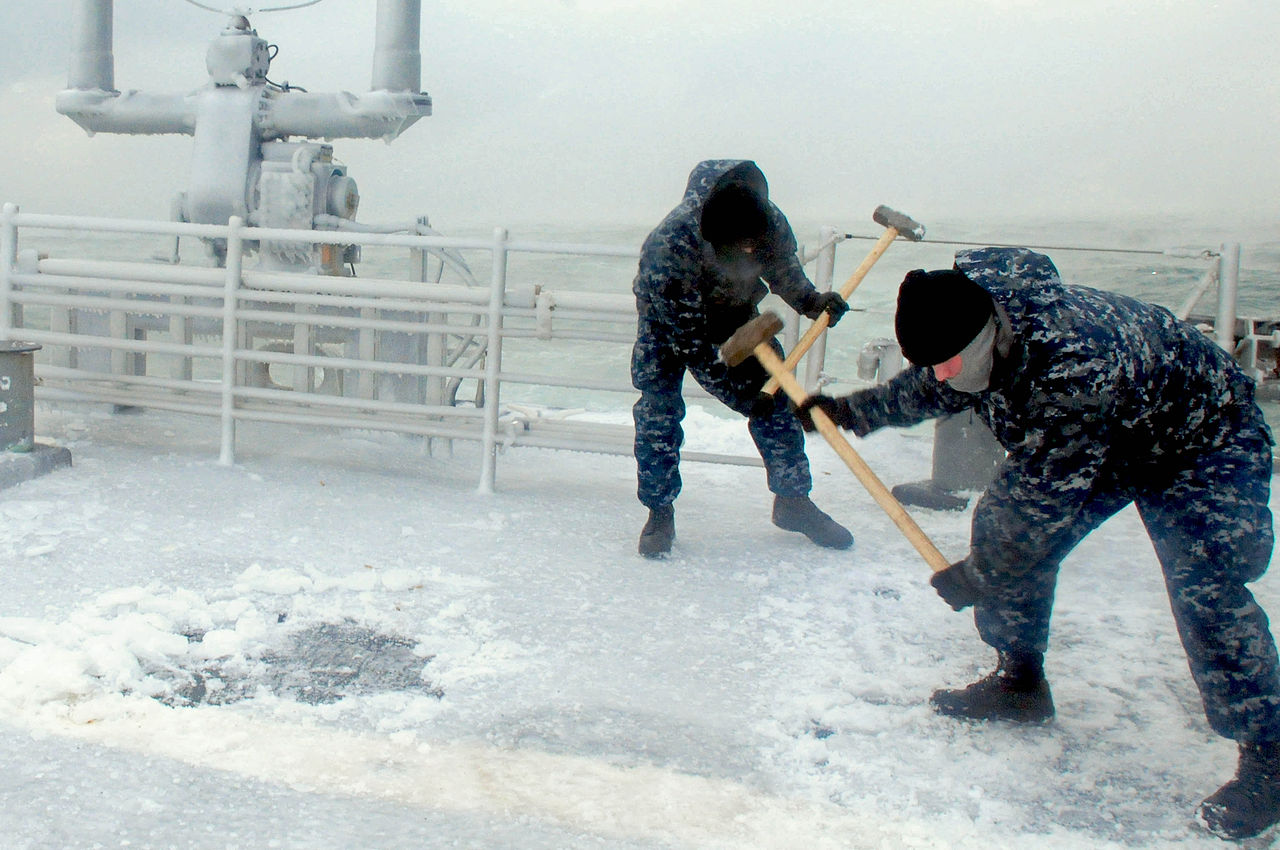
Sailors use sledgehammers to break ice on the cruiser Vella Gulf
Arctic operations pose special problems. Spray will freeze on a ship's upperworks, and the resulting ice has to be removed before it becomes a threat to the ship's stability.8 Seas are rougher than in much of the world, and weather is worse. Special care needs to be taken to make sure that everything is properly secured, and lubricants need to be checked to make sure they don't gum up.
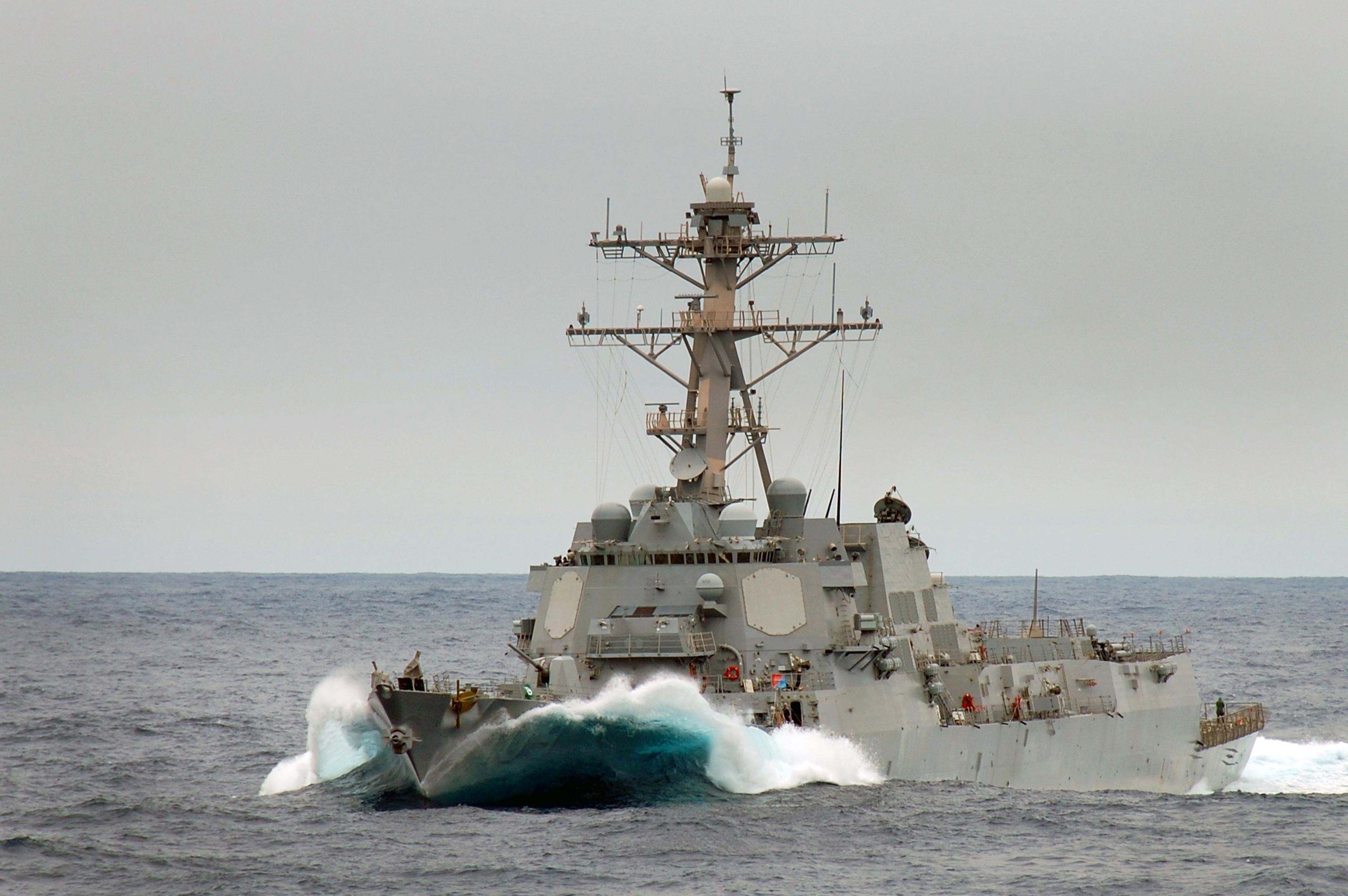
USS Jason Dunham in rough seas
The convoy routes to North Russia were particularly brutal. Navigation was difficult in the high latitudes, and German forces in Norway battered the ships. During the summer, constant daylight meant that attacks continued around the clock, denying the crews much-needed rest. The following clip shows some of the weather these ships encountered:9
Foul-weather operations have been an area of considerable focus since the end of WWII. In the aftermath of the war, submarines capable of high underwater speeds became common, and escorts needed to be able to hunt them in all weathers, as the submarines themselves were obviously unaffected by conditions on the surface. This usually meant bigger ships, and different hull forms. Before WWII, ships tended to be designed for the highest possible speed in smooth water, which greatly compromised performance in rough seas. Today, speed requirements include sea state. In practice, a modern Arleigh Burke, capable of 31 kts, is as fast as a WWII-era Fletcher, theoretically rated for 38 kts. The growth in size of warships has helped, but modern naval architects have a wide range of techniques for analyzing behavior in bad conditions that were unavailable to previous generations, and deploy them to keep ships operational in rough weather. One of the main advantages of Vertical Launch Systems (VLS) used in modern warships is that they have much larger motion limits than conventional rail launchers.
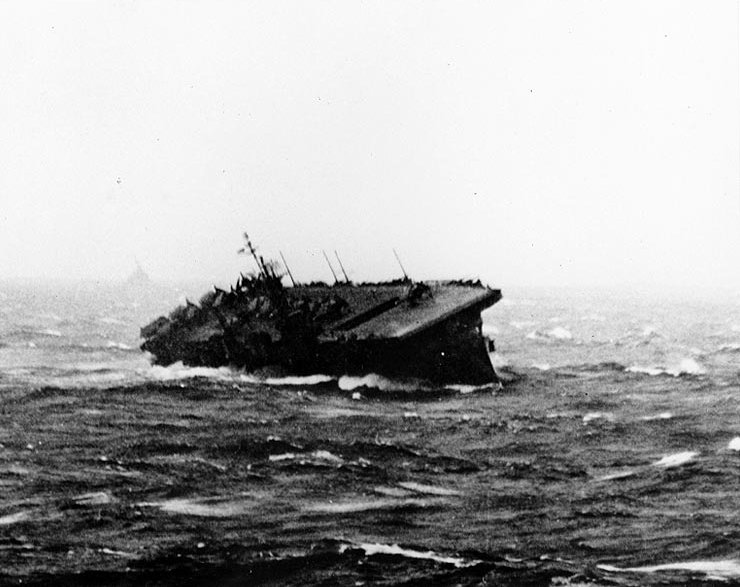
USS Langley during Typhoon Cobra
But occasionally, weather at sea can get extremely bad, so that even modern warships are essentially unable to fight. Rarely, they have to fight merely to survive. The most famous incident of this type was during WWII, when Admiral Halsey led the Third Fleet directly into the path of Typhoon Cobra. Many ships took extensive damage from the rough seas, and the carrier Monterey suffered a fire after aircraft broke loose in the hangar. Throughout the fleet, more than 100 planes were lost overboard, and nine warships had to be detached for repairs. But the worst casualties were the destroyers Hull, Monaghan and Spence, all three of which capsized. Spence was low on fuel, and had her tanks empty in preparation for refueling, which ultimately compromised her stability. Several of her sister ships ballasted their tanks with seawater and rode out the storm with relatively little trouble. The other two ships were older destroyers that had received a great deal of extra equipment, driving topweight up to unsafe levels. Astonishingly, 93 men were recovered from these three ships, but approximately 790 perished in the greatest non-combat loss of life in the history of the US Navy.
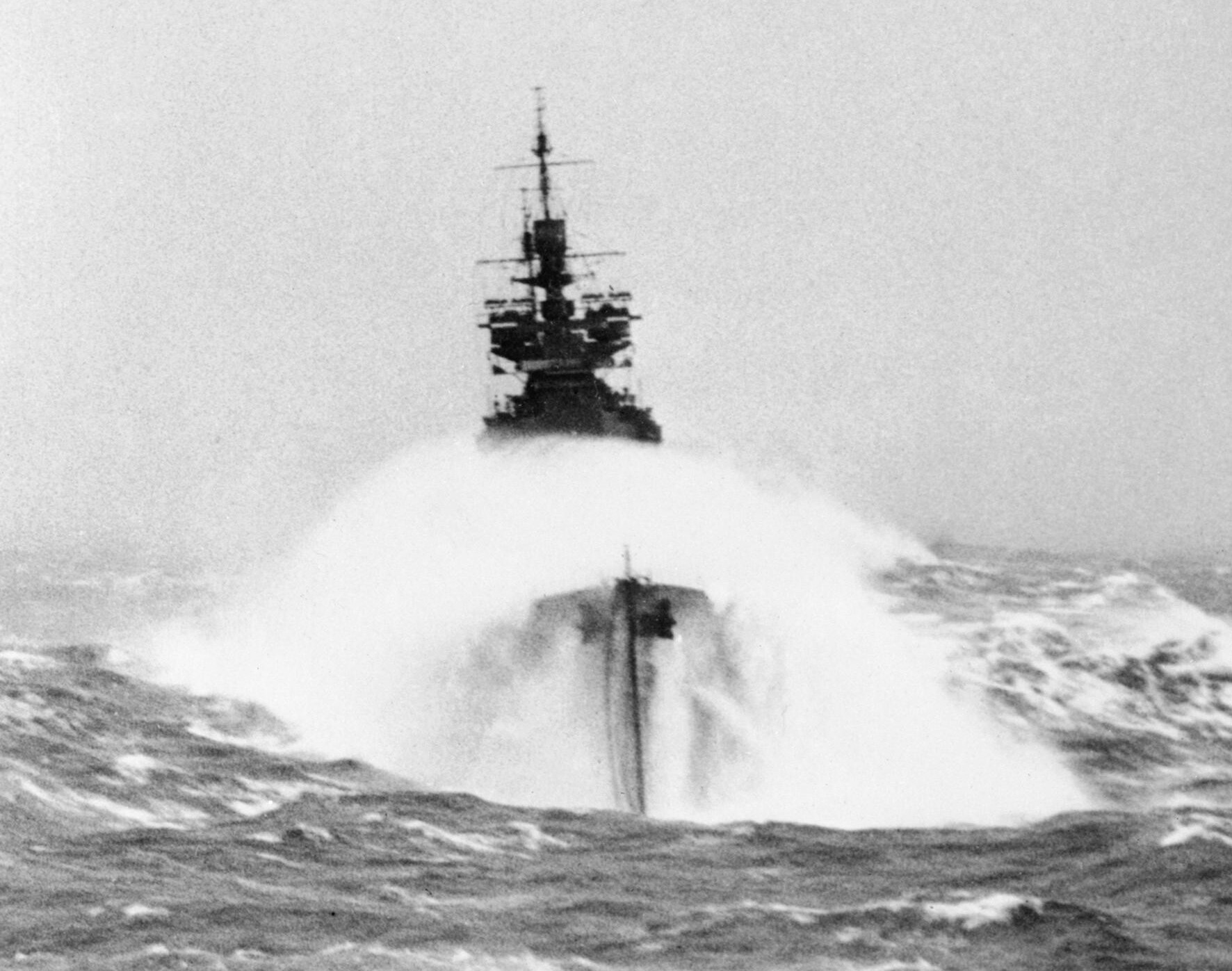
Battleship Duke of York battles waves while escorting a convoy to Russia
I've only been able to scratch the surface of what is a complex topic. For instance, wind and ship motion are both critical in aviation operations, but they fall outside the scope of this post.10 And there are certainly many details of seamanship that don't get written down where I can find them. But weather remains an important part of naval warfare today, and will undoubtedly be so as long as man fights at sea.
1 When this was originally written, the article stated that being upwind was not an advantage to the Germans because their shells were falling less steeply. This was wrong, and has since been removed. I don't have a range table for any of the guns involved (or at least I don't know where one lives offhand) but taking the 16"/50 AP shell as a baseline, a 10-kt wind along the line of sight would have changed the range of the shell by a maximum of 80 yards (at 26,000 yrds, about the maximum range of the engagement), reducing the angle of fall by 6.5' (about .1°) at that range. The actual guns might have been affected slightly more, but not enough to materially change penetration. As the range closed, wind deviation and resulting changes in angle of fall would have decreased even more. Having clear rangefinders is a much bigger advantage than a tiny decrease in angle of impact. ⇑
2 Vertical motion of the entire ship. ⇑
3 The clip is from about 18:45 onward in Episode 3 of the series Victory at Sea. The flashing lights you see from some ships are signal lamps in use. ⇑
4 The Greek root of the word nausea comes from their word for ship. ⇑
5 A very wide ship can also see fairly high vertical accelerations near the edges as it rolls. ⇑
6 Compare this to the Flower class corvettes of WWII, which were 205' long, and had a reputation for being terrible in the North Atlantic. It didn't help that the crew quarters were in the forecastle, where pitching was the worst. ⇑
7 The rule of thumb is that a ship should have a freeboard of at least 1.1*sqrt(length in feet). Almost all modern warships meet this criteria, but it was occasionally breached by ships of the WWII era, and egregiously violated by many of the ironclads. Needless to say, they were very, very wet. ⇑
8 The Truman strike group deployed to the arctic during Trident Juncture in 2018, the first time a USN carrier had been that far north since the early 90s. They consulted an old publication on Artic operations, and the first item for snow/ice removal was baseball bats. So Truman deployed with 48 Louisville Sluggers. I'm not entirely sure what they were used for, but I'd assume it was hitting things to break ice. ⇑
9 Like the previous clip, this is from Victory at Sea, specifically Episode 11. ⇑
10 This will probably be covered when I finally get around to discussing naval aviation operations, but that's not going to be soon. ⇑

Comments
If the props do get out of the water, is there any type of governor that keeps them and the shaft from overspeeding? Or is the time when they have no load on them so short that nothing can really be done?
I am thinking about all that mass and torque to suddenly go no-load. Any stories of powerplants being damaged this way?
I'm not aware of any governor, probably because it wouldn't work. The basic problem is that steam turbines in particular aren't that fast on the throttle. Gas turbines are better, but even they have measurable spool-up and spool-down time. There's just too much energy/mass flowing through to make stopping the engines quickly practical. And screws tend to come out for only short periods anyway.
It's certainly not a good thing for the plant, but I don't have any stories offhand of specific damage.
If nausea has such a big impact on ship effectiveness, are anti-nausea medications administered during critical times?
I'm not sure, and the books I looked into are from the design side, so I didn't run across anything during research. It's worth pointing out that most anti-nausea meds have side effects that will themselves decrease combat effectiveness, so that has to be balanced against the effects of the sickness itself. The Cruel Sea didn't mention the use of such medication, although I might have a book with more details at home.
Sickbay did keep stocks of dimenhydrinate, meclizine, promethazine and ondansetron on hand. The first two prevent seasickness pretty well but can make you into a zombie. Promethazine zombifies almost everyone, but can actually stop the barfing once it starts. Ondansetron doesn't work especially well on seasickness, but when it does, it's a miracle drug - mighty few side effects (it's mostly useful for nausea from drug side effects or from norovirus or food poisoning.)
They'd give you meclizine or dimenhydrinate if you asked for them - and since most folks are more impaired by nausea than by drowsiness, that's usually a good trade. My impression, though, is that they didn't start considering that a good trade until the late 1990s.
Interesting. What ship(s) was this on? I'd assume that the utility of such medications (relative to side effects) varies greatly with how good of a seaboat the ship is and where you are.
Re use in WWII, I strongly suspect that the mindset of the RN would be strongly opposed to chemical aids. Most officers apparently thought that discomfort was good for the men, to the point that there were serious worries that lend-lease destroyer escorts would spoil them with basic luxuries like "quarters which are a reasonable temperature even in the North Atlantic" and "food that is not cold and full of seawater by the time it gets on the table". I have no real explanation as to why they thought this way.
This was on both USNS Sirius (T-AFS 8) and USS Ramage (DDG 61). Anecdotally, this seems to be common on most USN ships now - other sailors said they did the same thing on USS Iwo Jima and USS Oscar Austin.
In my experience, meclizine didn't really knock most folks out (for me, it just made it so that when I racked out, I was out cold), so the impairment was pretty minimal. Definitely better than being too queasy to focus, at any rate.
In my experience anti-nausea drugs were theoretically available but not widely distributed. I didn't take any (but I wish I had a few times) so I don't know exactly what was in stock at sickbay, but my impression was that it was probably dramamine. Nobody talked about what it was, just that you should shove it down the throats of anyone junior who had symptoms and didn't go to medical themselves. Dramamine does make me drowsy but that wouldn't have made me less effective than the constant vomiting I suffered for a few days when we really got out to sea. In general that's the pattern though - people get badly seasick for a few days then get over it and don't normally experience it again for years, if ever. This is based on my experiences on a destroyer (USS Laboon, DDG-58). Other, larger ships I've been on didn't have seasickness be much of an impact. I'm sure they had some supplies onboard though.
Of course, a big factor on modern US Navy operations are sea state limits. They're usually significantly lower than other navies are willing to operate in, explicitly to avoid damage to the ships and crews.
I’ve heard about the USN’s relative reluctance to engage in heavy-weather operations, specifically relative to the RN, but not much more, and google isn’t turning up any quantification. I can think of several explanations:
The obvious. That we’re just unwilling to pay the price of being at the cutting edge in tactical terms. It’s pretty well-known that USN seamanship isn’t as good as that of the RN, most graphically displayed two years ago.
Our design criteria are different. The home of most European navies, the North Atlantic, is about as nasty as it gets. Much of the Pacific is calmer. During WWII, the USN’s design criteria were more lax than the RN’s, primarily because we were fighting in different waters. Yes, this probably cost us a few ships in Typhoon Cobra, but that was solvable by ballasting, and meant we could fit a lot more AA guns, which probably saved at least three destroyers. I could easily see it being the case that Burkes are more vulnerable to weather damage than Type 45s, because nothing is tradeoff-free, and making the ship better able to resist weather damage costs combat power.
The ratchet effect of having two different fleets. ComDesLant gets called in and asked why his repair bills are higher than ComDesPac, and you get that baked into the baseline.
A misguided belief that weather satellites are magic, and will always find a patch of calm water for us to do our stuff in. This is the only explanation I can come up with for some of the seabasing stuff, which doesn’t look like it would work in anything more than a light chop.
I’m sure there’s something I’m missing. Any RN sailors around to enlighten us?